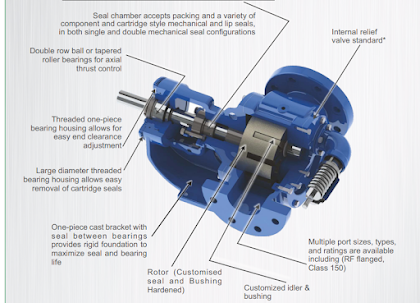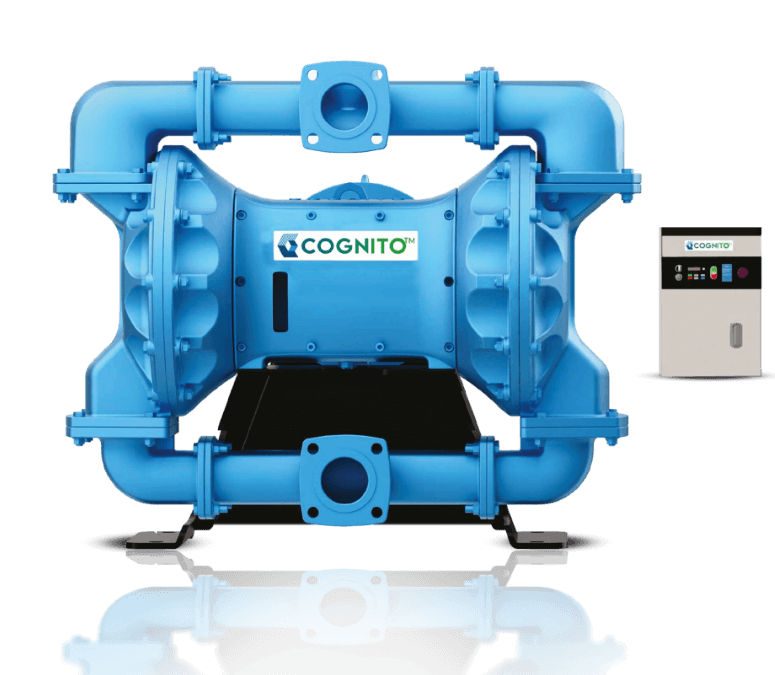Gear Pumps Selection Guide: Types, Features, Applications
 |
Gear Pumps Selection Guide: Types, Features, Applications
Gear pumps have earned a reputation for their efficiency and
reliability, characteristics that stem from distinctive features inherent to
their design. Notable among gear pumps features is their simplicity with a few
moving parts, making them highly reliable and easy to maintain. The design of
gear pumps facilitates the efficient handling of viscous fluids, showcasing
their high efficiency. These pumps possess the valuable capability of
self-priming, eliminating the need for an external suction source to initiate
pumping. Their versatility is evident in their ability to manage a broad
spectrum of fluid viscosities and pressures, rendering them suitable for a
diverse range of applications. Renowned for their durability, gear pumps are
constructed robustly, ensuring a long service life. These collective gear pumps features position
them as a preferred choice across various industries. The optimal selection of
a gear pump necessitates a comprehensive understanding of its operational
nuances, the available types of gear pumps, and the specific requirements of
the intended application.
How do I choose a gear pump?
Selecting the appropriate gear pump for your application is a
nuanced process that involves careful consideration of various factors. To
embark on this decision-making journey, the initial step is to gain a profound
understanding of your application's requirements. Questions about the type of
fluid the pump will handle, the viscosity of the fluid, and the desired flow
rate and pressure are integral in this regard. Following this, the choice
between external gear pumps, suitable for high-speed applications, and internal
gear pumps, ideal for handling high-viscosity fluids, needs to be made. Material
compatibility is crucial, necessitating consideration of construction materials
that align with the properties of the pumped fluid, especially in cases
involving corrosive or abrasive substances where more durable materials like
stainless steel may be required. Thoroughly checking the pump's specifications,
including capacity, pressure rating, speed, and power requirements, is crucial
to ensuring alignment with application needs. Assessing the reputation of the
pump manufacturer becomes a vital step, favoring those recognized for quality,
reliability, and robust after-sales service. It is imperative to invest the
necessary time and effort into making an informed decision, as the right gear
pump holds the potential to significantly enhance operational efficiency and
reliability.
What are the 2 types of gear pump?
Gear pumps are broadly classified into two types: External Gear
Pumps and Internal Gear Pumps. Let's delve into each one:
·
External Gear Pumps: These are the most common
type of gear pumps, consisting of two identical, interlocking gears. The
driving gear is connected to the drive motor, which turns the driven gear. As
the gears rotate, they create a void on the inlet side, which creates suction,
and the fluid is drawn into the pump. The fluid is then carried around the gear
teeth to the outlet side, where the meshing of the gears displaces the fluid.
·
Internal Gear Pumps: These pumps consist of a
gear within a gear. The outer gear (usually a rotor) has one tooth more than
the inner gear (usually an idler). The fluid is drawn into the pump at the
point where the gears come out of the mesh and is carried to the outlet in the
space between the teeth and the casing. The fluid is then forced out of the
pump as the gears mesh together.
Each type has its own advantages and is suited to certain
types of applications. External gear pumps are typically used for tasks
requiring high speeds, while internal gear pumps are better suited for handling
high-viscosity fluids.
How do internal gear pumps work?
Now, let's dive into the working mechanisms of both types of
gear pumps.
·
External Gear Pumps: In an external gear pump,
two identical gears rotate against each other. One gear is driven by the motor
(drive gear), which in turn drives the other gear (driven gear). When these
gears rotate, the space between them and the casing decreases on the discharge
side, creating a vacuum on the suction side. This vacuum draws fluid into the
pump. The fluid is then trapped in the spaces between the gear teeth and the
casing and is transported around the casing to the discharge side. As the gears
continue to rotate, the space on the discharge side decreases, which forces the
fluid out of the pump.
·
Internal Gear Pumps: An internal gear pump
consists of two gears: an outer (rotor) gear and an inner (idler) gear. The
rotor gear is driven by the motor, which drives the idler gear. The idler is
mounted on a pivot pin and rotates inside the rotor. As the gears rotate, they
create expanding volume on the inlet side, which draws fluid into the pump. The
fluid is then transported in the spaces between the gear teeth and the casing
to the outlet side. On the outlet side, the gears mesh together, which
decreases the volume and forces the fluid out of the pump.
In both types of pumps, the volume of fluid displaced with
each rotation is very precise, making gear pumps an excellent choice for
metering applications.
Conclusion
Gear pumps stand out in the realm of fluid handling for their remarkable efficiency and reliability, stemming from their simple design, versatility, and self-priming capabilities. The choice between external and internal gear pumps depends on the specific requirements of the application, with external gear pumps excelling in high-speed tasks and internal gear pumps proving ideal for handling high-viscosity fluids. Selecting the right gear pump demands a thorough understanding of the application's nuances, including fluid properties, flow rates, and pressure requirements. The diversity in gear pump types ensures their applicability across various industries, from handling corrosive chemicals to managing abrasive substances. Whether considering external or internal gear pumps, the meticulous evaluation of specifications and material compatibility, coupled with choosing a reputable manufacturer like Viking Pump from IDEX, ensures the optimal performance and longevity of the gear pump, ultimately enhancing operational efficiency.



Comments
Post a Comment